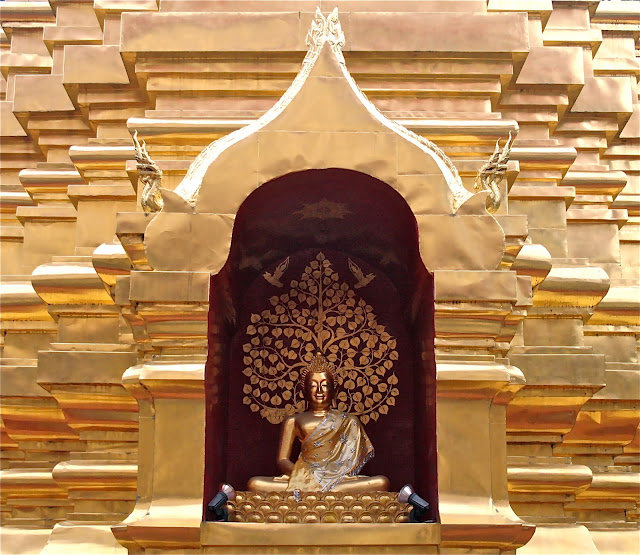 |
| A typical roadside vendor. This one serves up delicious fruit smoothies for 30 baht ($1). |
 |
| Tuk tuks are one of the two main modes of transport in Chiang Mai. The other is the two bench "songthao". |
It seems that fewer people are dictated by the clock in Chiang Mai. Shops may or may not open at the expected time, or perhaps not at all. I asked the receptionist at my hotel, "Where is the nearest place to eat breakfast?" She thought a minute, then said, "Nothing around here is open that early." I found that there are indeed some open early in the downtown area, catering mostly to foreign tourists.
Instead of the glitz of the enormous shopping malls of Bangkok, Chiang Mai has thousands of interesting tiny shops, and arts and crafts spread out in umbrella-covered market places. Instead of the sleaze of the capital city's sex massage parlors on Soi Cowboy and Patpong, Chiang Mai has traditional massage spots, many set in the shade of tree canopies on temple grounds. Of course, one can find these things in Chiang Mai, but they are not as obvious or prevalent.
 |
| Street markets are not only places to buy and sell: they are popular meeting places and social centers. |
 |
| No one looks at a clock in the market place. |
 |
| A relaxing one and a half hour foot massage at a temple, 180 baht ($5.50; $7 with tip). |
Fortunately, Chiang Mai has preserved much of its ancient architecture, and has an amazing number of stunning temples set among gardens and tree-lined walks. One resident told me that there are over 100 wats (temples) in the small original walled city, which can easily be covered on foot. Each wat offers a respite from the heat and street noise, and has unique qualities that set it apart from the others. Many are absolutely stunning, others have an understated elegance in the beautiful details of their artwork and decorations.
 |
| The magnificent staircase to Wat Doi Suthep atop a mountain outside of Chiang Mai. The scales of the "nagas" that line the steps are individually painted and fired ceramic tiles. |
 |
| A devotee circles the chedi (pagoda) at Doi Suthep three times. Many chant a meditation as they walk. |
 |
| Young girls in hill tribe outfits on the steps of Doi Suthep. This photo cost me (and other tourists) 20 baht (60 cents). They made a bundle, as you might imagine! |
 |
| Temple door detail, painstakingly hand painted. |
 |
| An altar set in a corner of a temple's grounds, overlooked by most visitors. |
 |
| Monks preparing candles and holy water for a gathering at a wat in Chiang Mai. |
 |
| Entrance to monks' quarters at a wat. |
 |
| Some of the decorative hangings and door carvings at wats are lovely. |
 |
| A roof (ceiling) of dried palm leaves woven in bamboo frames in a "sala" or outdoor seating area. |
 |
| Monk garments drying behind the dormitory. |
 |
| Gorgeous intricate inlays in a temple wall. |
 |
| Prayer bells, rung for good luck. |
 |
| Base of chedi (pagoda) with serene image. |
 |
| Chedi detail. |
 |
| Temple grounds offer a restful place to escape the city noise. |
 |
| Reminders are often posted on the grounds of wats. |
 |
| Beautiful "al fresco" paintings are often present on the walls of wats. |
 |
| A tuk tuk driver naps in a wat parking area. |
 |
| Window detail. |
